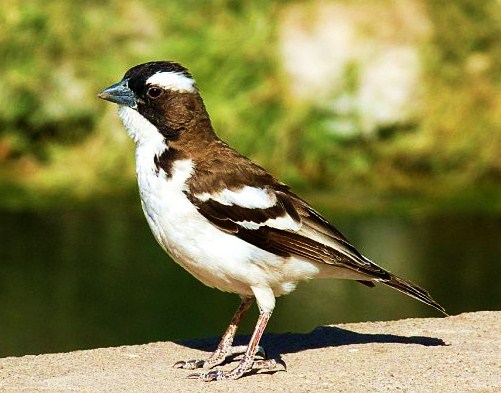Plocepasser mahali
 |
| (Photo from Blog Voyage Nature et Ornitho) |
Common name:
white-browed sparrow-weaver (en); tecelão-pardal (pt); mahali à sourcils blancs (fr); gorrión tejedor de ceja blanca (es); mahaliweber (de)
Taxonomy:
Order Passeriformes
Family Ploceidae
Range:
This species mainly occurs in two separate areas of sub-Saharan Africa. One extending from Ethiopia through Somalia and Kenya to Tanzania, and a larger population from Zambia to Tanzania south to Mozambique and the southern and eastern provinces of South Africa.
Size:
These birds are 16-18 cm long and weigh 40-55 g.
Habitat:
White-browed sparrow-warblers are mostly found in semi-arid Acacia and Mopane (Colosphermum mopane) savanna woodland, especially along the border between degraded and undisturbed habitat. They often nest along thornveld and scrubby, dry riverbanks.
Diet:
They mainly eat insects, seeds, fruit and fleshy leaves, doing most of their foraging in flocks of 4-10 birds, plucking food items from the ground. They are known to take Coleoptera, ants, termites, Hemiptera, Orthoptera, as well as the seeds of Stipagrostis, Uruchloa, wheat and maize.
Breeding:
The white-browed sparrow-warbler breeds throughout the year, but mainly in the warmer months. They nest in small colonies, with 10-12 pairs building their nest in the same tree. The conspicuous nest is an untidy oval of coarse, dry grass stems, looking like a loose bunch of straw. There the female lays 1-3 white or pale pink speckled eggs which the female incubates alone for 14 days. The chicks are mostly fed by the female and fledge 21-23 days after hatching.
Conservation:
IUCN status – LC (Least Concern)
This species has a very large breeding range and, although the global population size has not been quantified, the species is described as common to abundant. The population is suspected to be stable in the absence of evidence for any declines or substantial threats.







